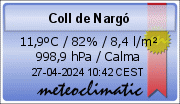"METEOROLOGÍA : SE CONFIRMA EL DIAGNÓSTICO DE SECO Y FRESCO".
Hola,
Ahora salgo de viaje hasta las 13 horas aproximadamente. Por la tarde espero poder publicar. Valga como avance del blog de más tarde y como continuación del de ayer la predicción de lluvia y temperaturas para Europa en los próximos 17 días. Queda claro, que de entrada nada de nada (o casi) tal vez apartir de 8 de febrero tengamos una tentativa de entrada atlántica que según parece ahora a lo sumo generará una "gota fría" en las zona de las Islas Canarias. Lo iremos vigilando. Temperaturas ligeramente por debajo de las normales (gracias a las noches muy frías).

EL CICLÓN TROPICAL "YASI" AMENAZA A AUSTRALIA
=============================================
Probablemente los daños darán que hablar en los próximos días.
Ciclon Tropical Yasi en Australia (cerca de Queensland)
Hurricane Season 2011: Tropical Cyclone Yasi01.31.11 NASA Sees Large Tropical Cyclone Yasi Headed Toward Queensland, Australia
NASA's Terra satellite captured an image of Yasi on Jan. 30 at 23:20 UTC (6:20 p.m. EST/09:20 a.m., Monday, January 31 in Australia/Brisbane local time). Although the image did not reveal a visible eye, the storm appears to be well-formed and also appears to be strengthening. Credit: NASA Goddard / MODIS Rapid Response Team Tropical Storm Anthony made landfall in Queensland, Australia this past weekend, and now the residents are watching a larger, more powerful cyclone headed their way. NASA's Terra satellite captured a visible image of the large Tropical Cyclone Yasi late yesterday as it makes its way west through the Coral Sea toward Queensland.
The Moderate Resolution Imaging Spectroradiometer (MODIS) instrument that flies aboard NASA's Terra satellite captured an image of Cyclone Yasi on Jan. 30 at 23:20 UTC (6:20 p.m. EST/09:20 a.m., Monday, January 31 in Australia/Brisbane local time). Although the image did not reveal a visible eye, the storm appears to be well-formed and also appears to be strengthening.
Warnings and watches are already in effect throughout the Coral Sea. The Solomon Islands currently have a Tropical Cyclone warning for the provinces of Temotu, Rennell& Bellona, Makira and Guadalcanal. The Australian Bureau of Meteorology has already posted a Tropical Cyclone Watch from Cooktown to Yeppoon and inland to between Georgetown and Moranbah in Queensland, Australia. The Australian Bureau of Meteorology expects damaging winds to develop in coastal and island communities between Cooktown and Yeppoon Wednesday morning, and inland areas on Wednesday afternoon. Updates from the Australian Bureau of Meteorology can be monitored at the Bureau's website at http://www.bom.gov.au/.
On January 31 at 1500 UTC (10 a.m. EST/ 1:00 a.m. Tuesday February 1, 2011 in Australia/Brisbane local time), Tropical Cyclone Yasi had maximum sustained winds near 90 knots (103 mph/166 kmh). Yasi is a Cathegory Two Cyclone on the Saffir-Simpson Scale.
It was centered about 875 miles E of Cairns, Australia, near 13.4 South latitude and 160.4 East longitude. It was moving west near 19 knots (22 mph/35 kmh). Cyclone-force winds extend out to 30 miles (48 km) from the center.
Animated infrared satellite imagery, such as that from the Atmospheric Infrared Sounder (AIRS) that flies on NASA's Aqua satellite, showed deep convective (thunderstorm) bands wrapping tighter into the low level circulation center. Wrapping bands of thunderstorms indicate strengthening.
Yasi is forecast to move west then southwestward into an area of low vertical wind shear (strong wind shear can weaken a storm). Forecasters at the Joint Typhoon Warning Center (JTWC) expect Yasi to continue strengthening over the next 36 hours. JTWC forecasts a landfall just south of Cairns as a large 100-plus knot (115 mph/185 kmh)n system by Wednesday. Residents along the Queensland coast should now be making preparations now for the storm's arrival.
Text Credit: Rob Gutro, NASA's Goddard Space Flight Center, Greenbelt, Md.
Escala abreviada de Saffir-Simpson
Mapa que de cumplirse para el día 9.02.2011 abriría ciertas esperanzas...
Las esperanzas se esfumarían 24 horas después,pero atención : Se puede formar una Gota Fría en las Canarias.
Seguiremos con temperaturas suaves de día,frías de noche,nieblas, contaminación,heladas y fusión de nieve en las montañas a causa de las inversiones térmicas.
La lentitud de la conexión internet en la zona pre-pirenaica es tan lenta que me aconseja dar el tema acabado por hoy. ¿Será el frío?. Ahora estamos a + 1,7ºC y las extremas han sido de +5,1ºC y -1,6ºC con viento de hasta 48 km/h.
Seguro que vendrán tiempos mejores, como ya los hubo.
Saludos.
Mariscal Tro
Fuentes: Cola /Iges, Ogimet, Wetter Zentrale,N.A.S.A. y propias.







1 Comments:
This article is interesting and useful. Thank you for sharing. And let me share an article about health that God willing will be very useful. Thank you :)
Obat Penghancur Benjolan di Leher
Pengobatan efektif Menghilangkan Benjolan di Payudara
Pengobatan Miom tanpa Operasi
Obat Tradisional Radang Tenggorokan
Pengobatan Sakit Pinggang secara Cepat & Efektif
Khasiat Daun Sirsak untuk Benjolan
Post a Comment
<< Home